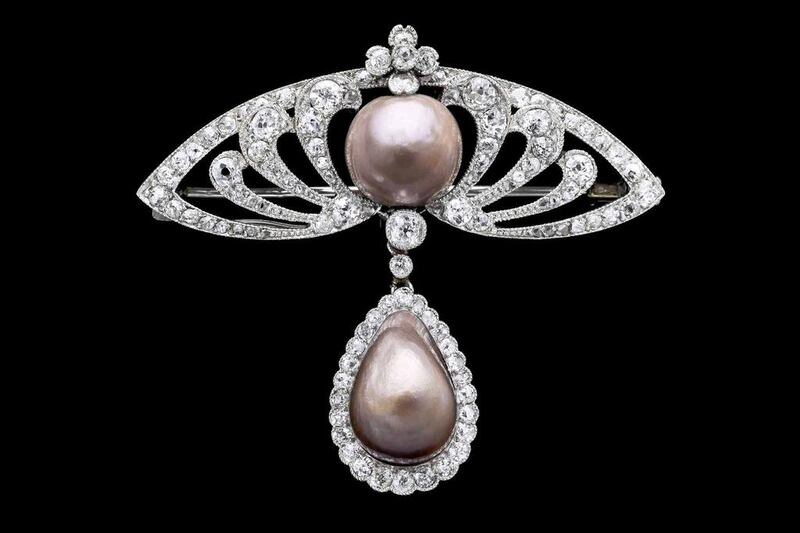As the models for the American label Badgley Mischka floated down the runway at New York Fashion Week last Tuesday, something fascinating occurred.
This is a forward-thinking label tailored for the red carpet, yet its new collection of gowns, palazzo trousers and skirts was embroidered with a gem whose history goes back many millennia, is intrinsically linked with the Arabian Gulf, and is more readily associated with the age of Marilyn Monroe or Elizabeth Taylor.
But the fact that Badgley Mischka was using pearls in the collection doesn’t surprise the jewellery historian Beatriz Chadour-Sampson. “Pearls are still culturally important and enjoyable to wear,” she says.
Chadour-Sampson is also a co-curator for Pearls, a new exhibition looking at the scientific, historical and cultural effect of the gem, opening at London’s Victoria & Albert Museum on Saturday. Well, newish. Its first incarnation was in Qatar in 2010 and a different version of the show travelled to Japan last year.
The London exhibition, however, is probably the most crowd-pleasing yet, more focused on the use of pearls in jewellery throughout history, from Roman times up to the present day, showing new pieces from the British Museum, the Royal Collection and Tate Britain. Even the pearl earring worn by the British King Charles I when he was executed in 1649 is on display.
But a loan from the Qatar Museums Authority (QMA) in Doha “embodies everything about the story of pearls” for Chadour-Sampson. “It’s a Cartier necklace from 1939 – Jacques Cartier used to travel to the Gulf to export pearls and the ones in this graduated necklace are of exceptional quality and lustre,” she says.
“But what you also have to remember is that there’s probably one pearl for every 2,000 oysters fished, so the amount of time that the fishermen had to spend underwater to achieve this necklace is staggering. They were out on the sea for months, encrusted in salt. We make sure in the exhibition that we pay tribute to these divers who risked their lives to get these beautiful pearls.”
So it’s right that the first sections of the new exhibition focus on the history of pearl discovery, fishing and trading in the Arabian Gulf. Chadour-Sampson’s co-curator Hubert Bari, from the QMA, is keen to emphasise that before the oil boom, pearl diving was one of the only ways to sustain the local economy in the region. “They’re not only beautiful gems; they have a long and interesting history,” he says. “Archaeological excavations confirm that pearls were being fished in the Gulf at least 7,000 years ago and traded with Northern Europe and China over 3,000 years ago. I think this is a story worth telling.
“We show that pearls are not only black or white but can be red, green, blue, pink, orange. What’s fascinating is that they were not worn in the Gulf itself as they were not seen as beautiful; they were instead a means to survive.”
Although there have been recent attempts to revive the practice in the Gulf, the combination of overfishing at the turn of the 20th century, the beginnings of the oil economy, the Great Depression and the advent of cultured pearls from the Japanese company Mikimoto was fatal to a thriving local industry.
But for Chadour-Sampson, Mikimoto Kokichi’s democratisation of jewellery – it was his dream that every girl should have a pearl necklace – is an important part of this exhibition, highlighted by the inclusion of a cultured pearl necklace given to Marilyn Monroe by Joe DiMaggio.
“I’m certainly not a purist,” she says. “Don’t forget that Jackie Kennedy promoted the use of pearls very much in the 1960s, but she was wearing imitation ones.”
But for all the connections with 20th-century opulence, the show actually draws to a close with a snapshot of contemporary pearl jewellery. Chadour-Sampson argues that they are still very popular with designers and jewellery houses – and she thinks she knows why.
“Pearls are amazing in their symbolism,” she says. “Across history they’ve represented not only happiness and sadness, authority and power, but also femininity and purity. To me, they’re a phenomenon.”
• Pearls, a V&A and Qatar Museums Authority exhibition, runs from Saturday to January 19 as part of the Qatar UK 2013 Year of Culture. Visit www.vam.ac.uk/pearls for more information
artslife@thenational.ae





